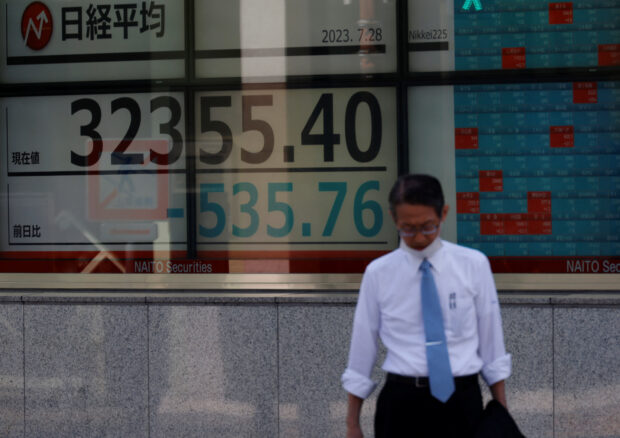Marketmind: Nikkei eyes 40,000

FILE PHOTO: A man stands in front of an electric board displaying the Nikkei stock average outside a brokerage in Tokyo, Japan, July 28, 2023. REUTERS/Kim Kyung-Hoon/File Photo
A look at the day ahead in Asian markets.
Stock markets in Asia start the week with clear momentum behind them, especially in Japan and China, but may be vulnerable to a spot of profit-taking as investors pause for breath after last week’s tech- and AI-fueled global buying frenzy.
The Asian economic calendar on Monday is light, with Japanese producer price inflation for January the main event, followed by industrial production from Singapore.
READ: Nikkei parties like it’s 1989; scales record high
China’s CSI 300 index of blue chip shares eked out a slender rise on Friday to seal its ninth straight day of gains and best run since January 2018. Another rise on Monday would mark its longest winning streak since late 2014.
Friday’s rise was only 0.1% though, suggesting fatigue may be setting in.
For Japan, however, there’s little sign of fatigue yet, at least not on the surface, with the Nikkei 225 surging more than 2% on Friday to a new all-time high. The 40,000-point mark will surely be traders’ near-term target now.
The weak yen continues to help make Japanese assets attractive to foreign investors, and the dollar goes into Monday’s session comfortably above 150.00 yen. Again, is a bout of profit-taking or even intervention imminent, or does recent momentum persist?
READ: Nikkei cruises to 34-year peak, briefly breaching 38,000 range
Hedge funds’ bearish positioning in the yen has grown to historically high levels, the latest U.S. futures market figures show, so perhaps the FX market is ripe for a correction.
The dollar has had a good start to the year, up 2.5% against a basket of G10 currencies and even more against some key Asian currencies, most notably the yen. Morgan Stanley analysts recommend trimming dollar exposure against emerging Asia.
Japanese services PPI ended last year running at an annual rate of 2.4%, the fastest in almost nine years, indicating that broader inflationary pressures are building.
But overall annual wholesale price inflation, when manufacturing sector is taken into account, is virtually zero. Services and manufacturing are giving off very different signals.
Monday’s services PPI comes a day before consumer inflation figures are released. The consensus is for core inflation to slow to 1.8% from 2.3% in December, which would be the first print below the Bank of Japan’s 2% target in almost two years.
Japan’s inflation rates are under close scrutiny as the BOJ prepares to lift interest rates into positive territory for the first time since 2016.
The main economic event in Asia this week could be China’s purchasing managers index data on Friday, as they will offer an early glimpse into how manufacturing and service sector activity have fared this month. A tentative rebound may be underway in Chinese stocks, but there’s little evidence yet of a similar recovery in the economic numbers.
The Chinese economic surprises index is barely in positive territory, even though expectations have been lowered substantially in recent months.
Here are key developments that could provide more direction to markets on Monday:
– Japan services PPI (January)
– Singapore industrial production (January)
– U.S. 2-year, five year bond auctions